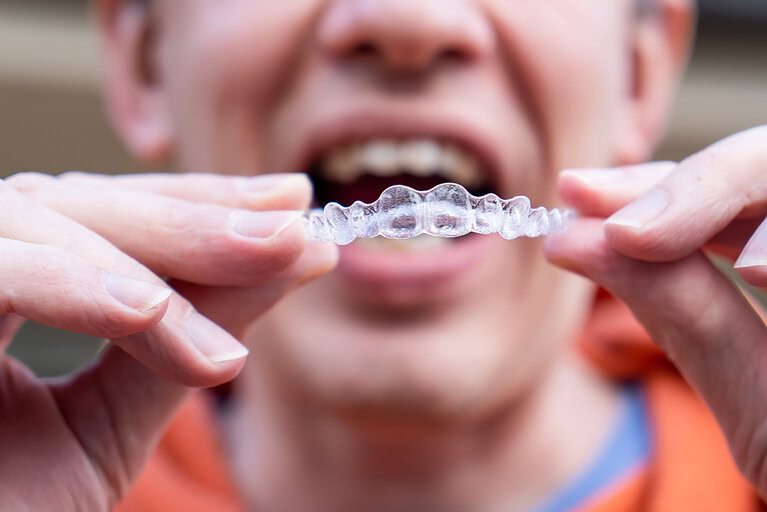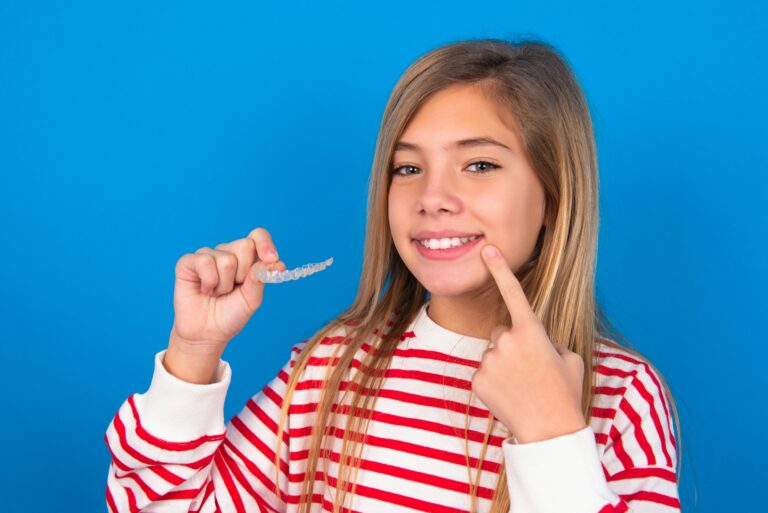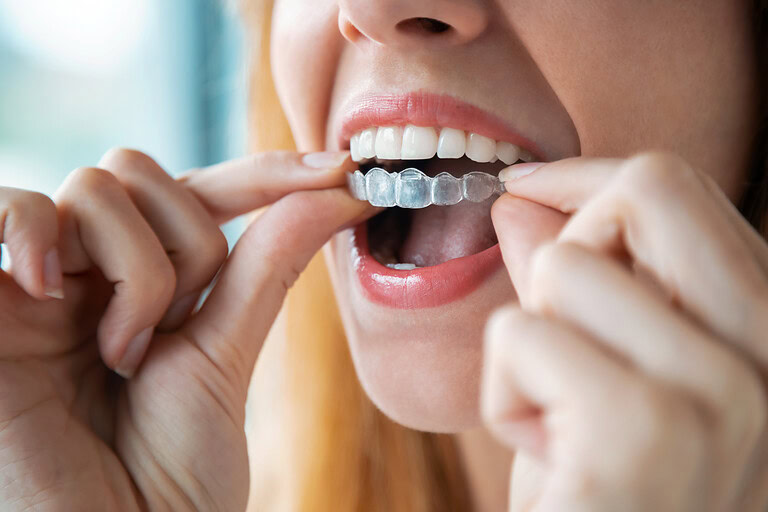Can You Whiten Your Teeth With Braces?
Can you whiten your teeth with braces is one of the most common questions orthodontic patients ask. While achieving a brighter smile is possible, there are some challenges to keep in mind such as uneven whitening around brackets, increased sensitivity, and the importance of proper timing.
Here are the safest ways to approach tooth whitening during braces treatment in Longmont or anywhere else. From at-home tools to professional in-office options, along with prevention strategies and tips for braces teeth whitening, we’ll outline what works best, whether for adults or braces for kids.

Why Teeth Discolor During Braces
During orthodontic treatment, teeth are more vulnerable to everyday discoloration. Dark beverages like coffee, soda, and wine can gradually leave stains on enamel. Food particles trapped around brackets and wires contribute to plaque buildup, which dulls tooth color over time. Additionally, tobacco use accelerates yellowing and increases the risk of stubborn surface stains, making whitening more challenging while braces are in place.
Beyond general staining, braces create unique challenges. The areas under brackets often remain shielded from cleaning and whitening, leaving lighter spots once brackets are removed.
This can result in a noticeable two-tone smile if prevention isn’t prioritized. These issues highlight why daily life with braces requires extra care and attention to keep your smile bright and even.
At-Home Whitening Approaches
Whitening Toothpaste & Mouthwash
Using whitening toothpaste and mouthwash is a safe option for all types of braces. These products are affordable and easy to incorporate into a daily routine, making them one of the most practical solutions for gradual braces teeth whitening. They work by scrubbing away surface stains and helping prevent new ones from forming. However, results take time and are generally less dramatic compared to professional treatments.
Electric Toothbrushes
An electric toothbrush can make a big difference during orthodontic care. Its powerful motion removes plaque and surface stains more effectively than a manual brush, even around brackets and wires. This not only improves overall oral hygiene but also enhances the appearance of a brighter smile.
Whitening Gels, Strips & Trays
Whitening gels, strips, and trays can provide noticeable results, but they’re only recommended for clear aligners or lingual braces. For traditional metal braces, these methods often create uneven whitening, leaving lighter or darker spots once brackets are removed. Additionally, gels and strips may cause tooth or gum sensitivity in some users. When used carefully and under guidance, they can be an effective tool for achieving a whiter smile mid-treatment.
Professional Whitening Treatments
In-Office Protocols
In-office whitening treatments use stronger bleaching agents combined with UV or laser light to deliver fast, noticeable results. However, these procedures are usually postponed until after traditional brackets are removed to avoid uneven coloring. For patients with clear aligners or lingual braces, supervised mid-treatment whitening may be an option since the whitening solution can better reach tooth surfaces. Consulting your orthodontist ensures the right timing and approach, reducing risks like sensitivity or patchy results.
Professional Take-Home Kits
Dentists may also recommend professional take-home kits, such as Ultradent’s Opalescence Go™. These pre-filled whitening trays are designed to penetrate the enamel, even beneath brackets, providing more consistent whitening than standard over-the-counter products. They also contain added benefits like fluoride, which strengthens enamel and protects against cavities during orthodontic care. This makes them a safe and effective choice for patients seeking gradual but reliable whitening results while wearing braces.
Prevention & Maintenance Tips
Daily Oral Hygiene
Keeping teeth clean during orthodontic care is the best way to prevent stains. Patients should brush after meals, floss with threaders, and rinse often to reduce plaque buildup around brackets and wires. At Longmont Braces we emphasize preventive care as the foundation for both oral health and lasting whitening results.
Diet & Lifestyle Adjustments
Everyday choices also affect brightness. Limiting staining foods and drinks such as coffee, tea, and soda helps minimize discoloration. Reducing acidic items prevents enamel erosion, and avoiding smoking protects against stubborn yellowing. These small adjustments make a noticeable difference throughout treatment.
Braces Colors for Whiter Teeth
Choosing the right braces colors can instantly enhance the appearance of your smile. Darker bands, such as navy, forest green, or even black, create contrast, making teeth look whiter. This aesthetic boost adds confidence during treatment, allowing patients to enjoy a brighter smile even before their braces come off.
Cost Considerations
When planning for whitening, it’s important to consider overall expenses alongside the cost of braces for kids and adults. Over-the-counter products like whitening toothpaste, mouthwash, or strips are generally more affordable and easy to incorporate into daily routines, though they deliver gradual results.
On the other hand, professional whitening treatments, such as in-office procedures or dentist-prescribed take-home kits, require a higher investment but provide faster and more consistent outcomes. By weighing the value of convenience, cost, and effectiveness, patients can choose the option that best supports their whitening goals throughout their orthodontic journey.
Expert Insights
Trusted orthodontists like Dr. Ross and Dr. Peterson emphasize that whitening during orthodontic care should never be a one-size-fits-all approach. Every patient’s teeth, appliance type, and sensitivity levels are different, which makes an individualized treatment plan essential for safe results.
Timing is also critical, some methods work well mid-treatment, while others are best reserved until braces are removed. Consulting directly with your orthodontist ensures you avoid uneven whitening or unnecessary risks. Professional guidance provides peace of mind and helps you achieve a brighter, healthier smile at the right stage of your orthodontic journey.
FAQs
Can you do teeth whitening with braces at home?
Yes, but results vary. With metal braces, strips and gels can cause uneven shades. Safer picks are toothpaste, mouthwash, or an electric toothbrush for gradual whitening.
Is whitening safe for kids during braces treatment?
For kids, whitening is usually delayed until after treatment. Gentle toothpaste is fine, but stronger products should wait.
How to keep teeth white with braces if I drink coffee or soda?
Brush or rinse after drinks like coffee or soda, use a straw, and stick with whitening toothpaste and mouthwash to limit stains.
Will whitening damage enamel or brackets?
Whitening won’t harm enamel or brackets if used correctly. The main risk is sensitivity or uneven shades after braces.
What’s the best time to whiten, during or after braces?
With metal braces, whitening works best after removal. Clear aligners and lingual braces may allow safe mid-treatment whitening.
Are natural remedies like baking soda safe with braces?
Baking soda can help but is abrasive. Overuse may harm enamel, so it’s safer to stick with orthodontist-approved products.







